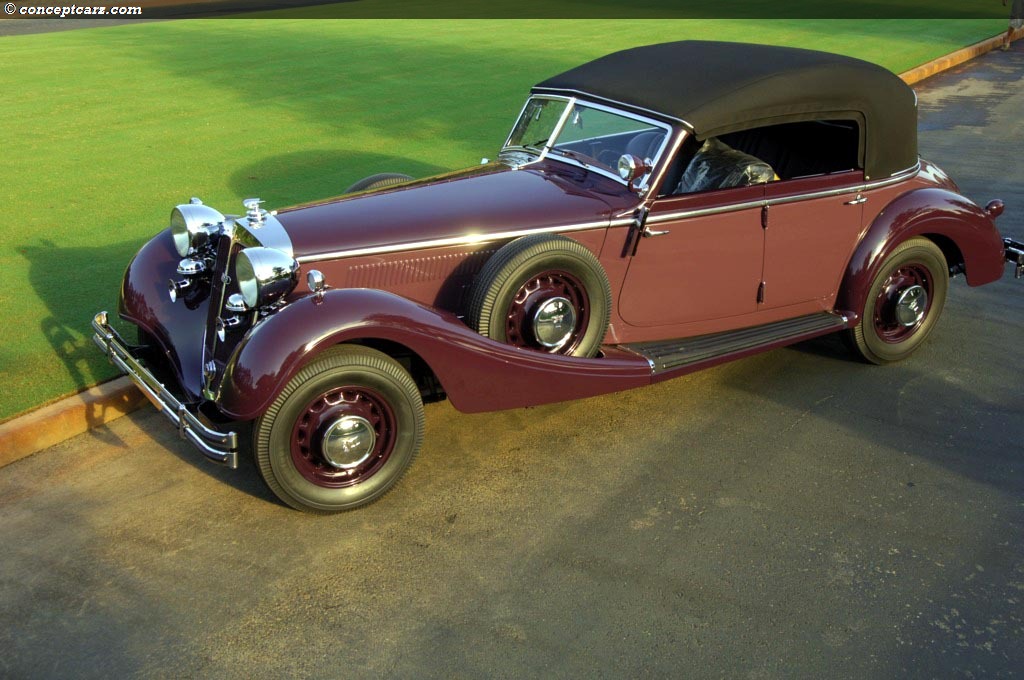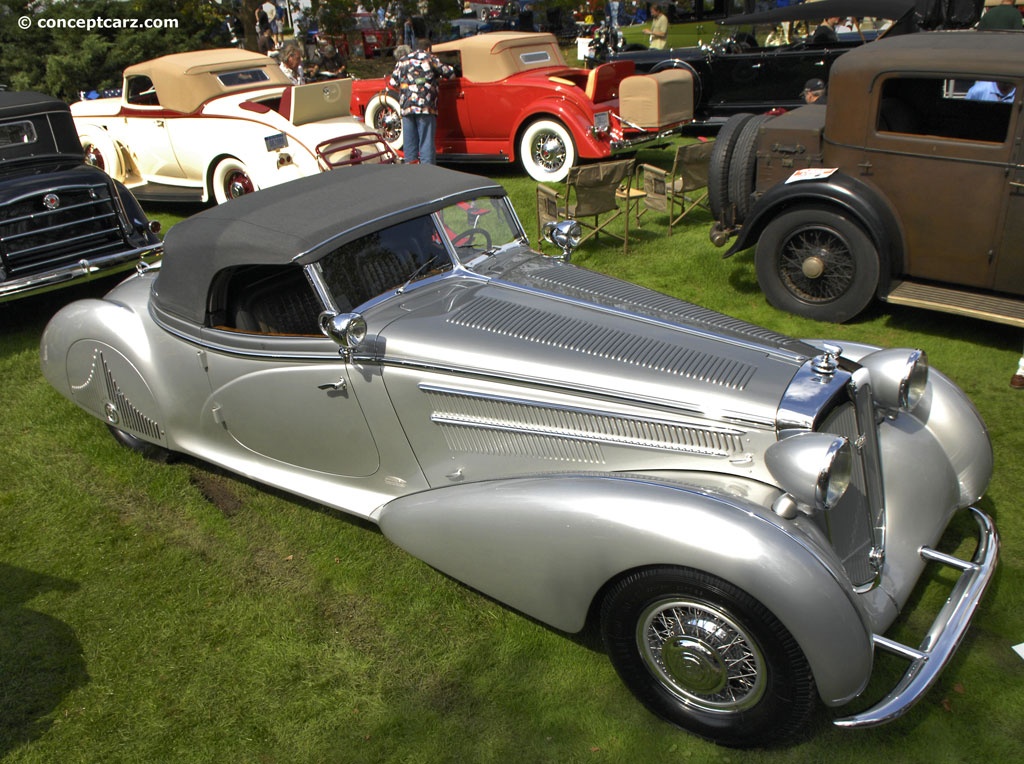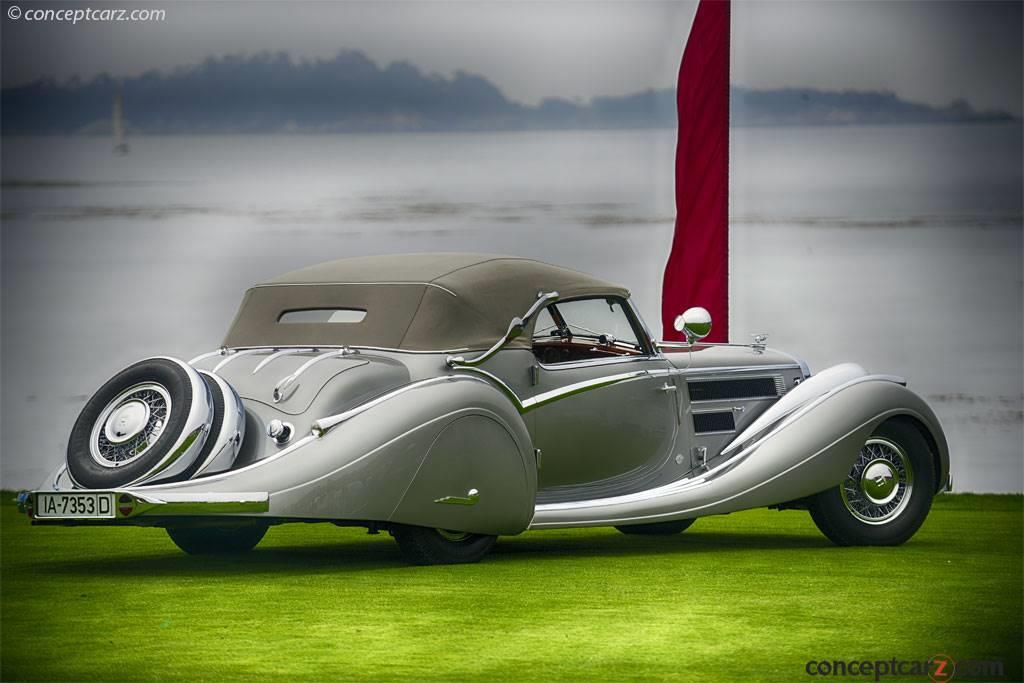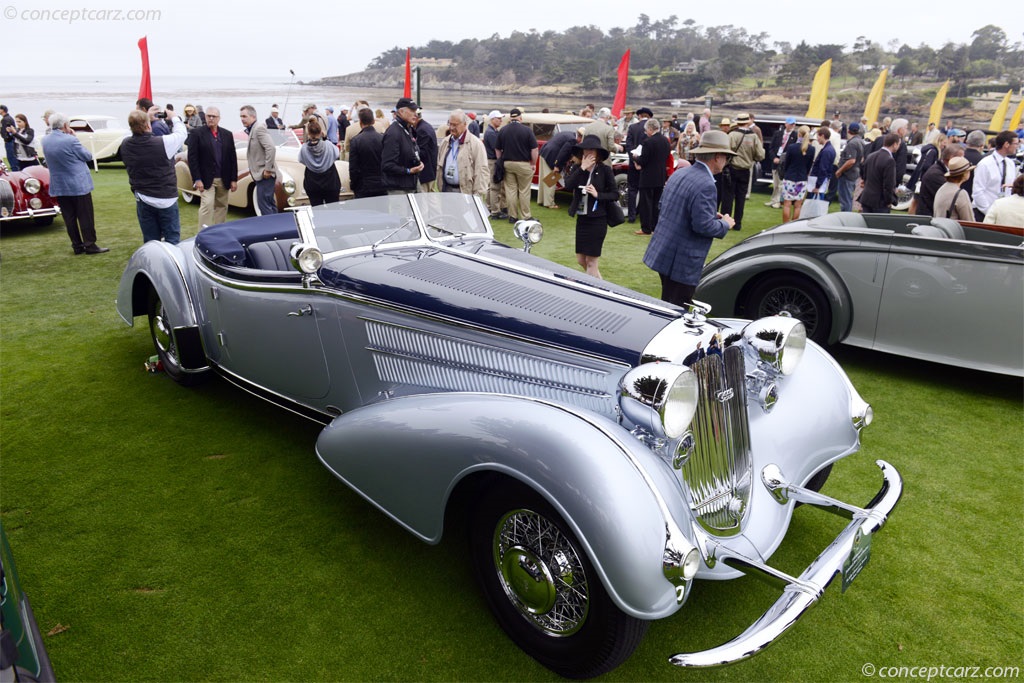August Horch was an automobile pioneer and a founding father of the German automobile industry. His initial car is regarded as the first German vehicle with a shaft-driven rear axle. Born in Winningen in 1868, he worked as a blacksmith, received an education at an engineering school, and then worked for a marine engine manufacturer in Leipzig. He later accepted a job managing Karl Benz's motor works at Mannheim from 1896 before founding A. Horch & Co. in November 1899 in Ehrenfeld, Cologne, Germany. The first Horch automobile was built in 1901 and is regarded as the first German vehicle with a shaft-driven rear axle. The company relocated to Reichenbach in 1902 and Zwickau in 1904. Following a dispute, Horch left the company in 1909 and set up a new firm in Zwickau initially called Horch Automobil-Werke GmbH. This triggered a legal dispute over the use of the Horch name, as the Horch name was a registered trademark of August Horch's former partners. So the name was changed to Audi Automobilwerke GmbH in 1910. Audi was sold back to Horch, then merged in 1932 with DKW and Wanderer as Auto Union. Production of Horch automobiles remained separate from these ventures. 
Phaeton
View info and historyInterestingly, Horch means 'Listen!' in German while 'Audi' is Latin for 'I am listening.'Early Horch Automobiles
The Horch automobiles were initially powered by a twin-cylinder engine with an alloy crankcase, a friction clutch, and produced 4.5 horsepower that was sent to the wheels via a driveshaft. It wore a simple open-body design that used candles housed in lanterns for lighting. Early Horch innovations included a carburetter with spray jets and a constant-mesh sliding gear transmission. A larger, four-cylinder engine arrived by March of 1902. Although there were financial difficulties, the company went public by 1904 and was renamed Horch & Cie Motorenwagen-Werke AG with a capital of 110,000 Marks. They produced thirty vehicles in 1940 and twenty-nine the following year. A six-cylinder model appeared in 1907. The Horch Company promoted their vehicles through trials and competitions of the day, and unfortunately, this policy would bring August Horch into conflict with his fellow directors and force his departure in 1909. In 1905, Horch entered his cars in the first Herkomer trial, and a year later, the Horch board of directors won the event with a 22-horsepower model. The company's new six-cylinder car built in 1907 entered the Emperor's Prize race in the Taunus hills, but its failure was used by the board of directors to attack their founder's ambitious multitude of projects. After the 23/40 horsepower streamlined torpedo-shaped vehicle built for the 1909 Prince Henry race was met with disappointing results, board members terminated the contract with August Horch on June 19th, 1909. August Horch's next venture, Audi, was successful in competition, with victories in the Austrian Alpine Rallies from 1912 to 1914. A. Horch retired from active management of Audi in 1920 but remained a member of the supervisory board.
Roadster by Erdmann & Rossi
Chassis #: 854275
Engine #: 852006
View info and history
Auction entries : 1With August's departure from Horch, the company focused on becoming a paragon of luxury and developed a reputation for its elegant and beautifully engineered automobiles. Before World War I, the company introduced the 18/50 double phaeton, with the 25/60 horsepower being the flagship model. At the lower end of the market was the 14-horsepower 'Pony' model. During World War I, the company produced trucks. When peacetime returned, the company resumed motor car production.Their quest for excellence was further reinforced in the mid-1920s with the introduction of a new model equipped with a straight-eight. Paul Daimler, son of Gottlieb, became Chief Engineer of Horch in 1923, and the first car to bear his expertise was the '300,' which used a 3.2-liter, double-overhead-camshaft, straight-eight engine. This was Germany's first eight-cylinder model. When Daimler left, Fritz Fiedler (later of BMW fame) took over, designing a single-overhead-cam straight-eight - the Horch 450. In 1931, Horch introduced the 600 and 670 models equipped with a 6.0-liter V12 engine. In 1933, the 3.5-liter V8-engined 830B model appeared.The Horch Eight
Horch offered a veritable plethora of model variations during the late 1920s and 1930s, with multiple engine capacities, wheelbase sizes, and coachwork styles. Although they had a diverse lineup, their product was aimed at the prestige end of the market where Horch was the only serious domestic rival to Mercedes-Benz. The production volume of Maybach was very exclusive and small and did not pose much competition to Mercedes-Benz. During the 1930s, Horch experimented with V12 and V8 power, but it was the straight-8 that Horch favored.
Sport Cabriolet by Voll & Ruhrbeck
Chassis #: 853558
View info and historyThe straight-8 engine powering the Typ 303/304 of 1926 had a 3,132cc displacement size and developed nearly 60 horsepower. Displacement rose to 3,378cc a year later, and horsepower increased by four. It grew to 3,950cc in 1928 and to 4,517cc by 1931. By 1935, it had reached nearly 5 liters and offered approximately 100 horsepower.The Horch company prospered with strong domestic and export sales through 1929. Like the rest of the world, the Wall Street Crash of October 1929 was a difficult storm to weather. As a result, very few of the single overhead camshaft Type 450 models were produced from 1931 to 1933. Horch launched the Type 830 in 1933, followed by the 850 in 1934. The pinnacle of the straight eight-cylinder models was built between 1937 and 1940 with the Type 853 and 951. The Horch 853
The Type 853 was introduced in 1936 and was powered by a Fiedler-designed, single-overhead-camshaft, ten-bearing straight-eight mounted installed in a robust chassis and backed by a four-speed overdrive gearbox with a lever-actuated overdrive that was usable in all four gears. Braking was handled by servo-assisted hydraulic drums. The chassis received a double-jointed rear axle shaft first introduced on the Auto Union racing cars, providing fully independent de Dion rear type suspension. In the front was an upper A-arm setup with the lower hub carried by transverse leaf springs. The 4.9 liter (4,494cc) engine used a single Soxle 35 JFF carburetor and developed 100 horsepower at 3,600 RPM. A supercharger was contemplated but ultimately the straight-eight engine was deemed sufficient. The '853 A' model of 1937 came with a more powerful 120-horsepower version of the straight-eight engine.
Roadster by Erdmann & Rossi
Chassis #: 854237A
View info and historyThe 853/853a was produced up to the onset of war, by which time 950 cars had been built. The company offered factory coachwork or it could be clothed by outside coachbuilders.Among the bodies built for this model was the Sportcabriolet by Glaserkarosserie who had a history building bodies for Horch. Heinrich Glaser's original company ceased to exist after WW2, making it difficult to track ownership history as all factory records were either lost or destroyed. Damage from bombs forced the relocation of the Glaserkarosserie in February of 1945 from its Dresden location to Ullersricht, near Weiden in Bavaria, where owner Erich Heuer resumed production after the war.The 853 had an advanced chassis and was endowed with technical prowess, but with Mercedes-Benz's new 540K, the rivalry between the two reached new levels. Both companies were competing for the same business, particularly parade cars for high-ranking members of the Third Reich. To that end, the Horch factory works in Malan began building a 'Special Roadster,' initially carved out of wood. What was known as the 'First Series' followed closely to the wooden design. The second example was built by the leading coachbuilders from Berline, Erdmann and Rossi. The first example of the 'Second Series' was built specifically for Herman Goring, commander-in-chief for the German Luftwaffe. Mercedes-Benz also built a special 540K for Goring, but it had more protection than the Horch. The Horch had a bulletproof windscreen while the Mercedes-Benz had bulletproof doors and glass, as well as the windscreen. Goring selected the Mercedes and ordered the Horch to be dismantled. It is believed that the final example is no longer in existence, leaving just three surviving cars.
Phaeton
View info and historyMercedes-Benz produced twenty-five examples of the 540K Special Roadster and each example is considered a one-off, but their appearances are similar and only vary slightly in detail. Eight Horchc Special Roadsters of all types were built including the prototype with factory coachwork. The subsequent examples were clothed by independent coachbuilders Erdmann & Rossi, and Glaser built the final example. Each of the Horch Special Roadsters is truly unique with some having a 'sweep panel' in the body side, some with skirts and some without, and at least two had the blade-style bumpers, while others had traditional Hoch 853 style bumpers. Some wore louvered rear fender skirts, and at least three different interior patterns were used. Among the factory coachwork was the Sport Cabriolet, which Erdmann & Rossi, Voll & Ruhrbeck, and Glasser built variations of this design. It was elegant and modern, with flowing lines and pontoon-shaped wings. After World War II, Horch's Zwickau factory ended up on the eastern side of the border, where it would eventually be pressed into service manufacturing the utilitarian Trabant.
by Daniel Vaughan | Sep 2008

Phaeton
View info and history
The Horch automobiles were initially powered by a twin-cylinder engine with an alloy crankcase, a friction clutch, and produced 4.5 horsepower that was sent to the wheels via a driveshaft. It wore a simple open-body design that used candles housed in lanterns for lighting. Early Horch innovations included a carburetter with spray jets and a constant-mesh sliding gear transmission. A larger, four-cylinder engine arrived by March of 1902. Although there were financial difficulties, the company went public by 1904 and was renamed Horch & Cie Motorenwagen-Werke AG with a capital of 110,000 Marks. They produced thirty vehicles in 1940 and twenty-nine the following year. A six-cylinder model appeared in 1907. The Horch Company promoted their vehicles through trials and competitions of the day, and unfortunately, this policy would bring August Horch into conflict with his fellow directors and force his departure in 1909. In 1905, Horch entered his cars in the first Herkomer trial, and a year later, the Horch board of directors won the event with a 22-horsepower model. The company's new six-cylinder car built in 1907 entered the Emperor's Prize race in the Taunus hills, but its failure was used by the board of directors to attack their founder's ambitious multitude of projects. After the 23/40 horsepower streamlined torpedo-shaped vehicle built for the 1909 Prince Henry race was met with disappointing results, board members terminated the contract with August Horch on June 19th, 1909. August Horch's next venture, Audi, was successful in competition, with victories in the Austrian Alpine Rallies from 1912 to 1914. A. Horch retired from active management of Audi in 1920 but remained a member of the supervisory board.

Roadster by Erdmann & Rossi
Chassis #: 854275
Engine #: 852006
View info and history
Auction entries : 1
Horch offered a veritable plethora of model variations during the late 1920s and 1930s, with multiple engine capacities, wheelbase sizes, and coachwork styles. Although they had a diverse lineup, their product was aimed at the prestige end of the market where Horch was the only serious domestic rival to Mercedes-Benz. The production volume of Maybach was very exclusive and small and did not pose much competition to Mercedes-Benz. During the 1930s, Horch experimented with V12 and V8 power, but it was the straight-8 that Horch favored.

Sport Cabriolet by Voll & Ruhrbeck
Chassis #: 853558
View info and history
The Type 853 was introduced in 1936 and was powered by a Fiedler-designed, single-overhead-camshaft, ten-bearing straight-eight mounted installed in a robust chassis and backed by a four-speed overdrive gearbox with a lever-actuated overdrive that was usable in all four gears. Braking was handled by servo-assisted hydraulic drums. The chassis received a double-jointed rear axle shaft first introduced on the Auto Union racing cars, providing fully independent de Dion rear type suspension. In the front was an upper A-arm setup with the lower hub carried by transverse leaf springs. The 4.9 liter (4,494cc) engine used a single Soxle 35 JFF carburetor and developed 100 horsepower at 3,600 RPM. A supercharger was contemplated but ultimately the straight-eight engine was deemed sufficient. The '853 A' model of 1937 came with a more powerful 120-horsepower version of the straight-eight engine.

Roadster by Erdmann & Rossi
Chassis #: 854237A
View info and history

Phaeton
View info and history
by Daniel Vaughan | Sep 2008
Related Reading : Horch 853 History
August Horch began producing vehicles with Karl Benz before 1899, after which he built vehicles under his name, August Horch %26 Cie. In 1909, after disputes with shareholders, he departed from his company and founded Audi, which is the Latin translation of his surname. The production of the Horch automobile continued without their founder using his name. In the early part of the 20th century, automobiles....
Continue Reading >>
Continue Reading >>
Similarly Sized Vehicles
from 1938
1938 Horch 853 Vehicle Profiles
Recent Vehicle Additions
Performance and Specification Comparison
853 Specification Comparison by Year
Year
Production
Wheelbase
Engine
Prices
Related Automotive News

Pebble Beach 'Best Of Show' Winning Horch Returns To Monterey Peninsula For Auction
A stunning, multi-award winning 1938 Horch 853A Erdmann %26 Rossi Sport Cabriolet, judged Best of Show at the 2004 Pebble Beach Concours dElegance, will return to Californias Monterey Peninsula, August 17–18, as a featured attraction at RM Auctions...

Pebble Beach 'Best Of Show' Winning Horch Returns To Monterey Peninsula For Auction
A stunning, multi-award winning 1938 Horch 853A Erdmann %26 Rossi Sport Cabriolet, judged Best of Show at the 2004 Pebble Beach Concours dElegance, will return to Californias Monterey Peninsula, August 17–18, as a featured attraction at RM Auctions...
































